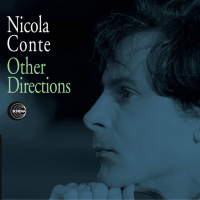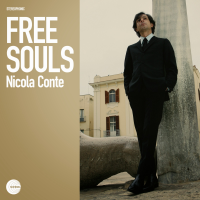Home » Jazz Musicians » Nicola Conte
Nicola Conte
To comprehend fully Nicola Conte's music originality and sensibility we should refer, together with his productions, to the unavoidable Fez's activity, a cultural movement founded by Conte himself in Bari in the early nineties. A real melting pot of several creative musicians, who first of all are friends and grew up together with the same intellectual, music and political similarities. Cultural trouble-makers, emotional dreamers, Jazz enthusiasts of the fifties and sixties, deep "nouvelle vague" connoisseurs, compulsive vinyl collectors, design and graphic experts, people crazy for cultural beat and books written by revolutionaries like Jean Paul Sartre and Boris Vian.
The atmosphere at Fez seemed to be the same detectable at Tabou, the legendary "caveau" in Saint Germain de Pres, described by Vian himself. It is place where it was possible to listen to records, watch cult movies of those two decades ('50s and '60s) and look for solutions to the intellectual uncomfortableness.
Today, some years later, one of the strongest expressions highlighted at Fez is still that of the music.
In that period Fez became the reference point for the artists involved in the acid Jazz scene, really fashionable in London; Nicola Conte is considered the irreplaceable link with our country: he brings artists already famous abroad but still unknown in the Italian clubs. Sociologically in the past we would have defined Fez a perfect example of cultural decentralization "ante litteram," far from the neuralgic centre of the country.
Through Nicola Conte's efforts Fez started to be recognized as a cultural movement for all practical purposes. Then he decided to direct his ideas on the music productions: he began collaborating as a remixer at Schema Records and he created bands like Paolo Achenza Trio, QuintettoX, Fez Combo, Intensive Jazz Sextet and Balanço. Their works well underline Nicola's love for global Jazz and reveals his other great passions to us, like the soundtracks—especially the old Italian productions by Piero Piccioni e Ennio Morricone—and the Brazilian genre Bossa Nova.
The three different styles strongly connected—Jazz, soundtracks and Bossa Nova—are well expressed in the nineties productions and strictly bounded to the afro roots which generated bands like Jazz Convention, Quartetto Moderno, Rosario Giuliani Quartet, Schema Sextet. Among those artists adhere to Nicola's ideas and always active in these bands we mention Fabrizio Bosso, Gianluca Petrella, Lorenzo Tucci, Gaetano Partipilo, Pietro Lussu, Rosario Giuliani.
Nicola in '99 decided to produce his entry record, Jet Sounds, released in 2000. "Jet Sounds" is an elegant fusion among typical Italian sonorities, connected to the cinema and influenced by Jazz, Bossa Nova and psychedelic music. After this record Nicola continued working both as a producer and as a DJ in various worldwide clubs. In the meantime he started making himself noticed as a composer and musician. The single "New Standards" is the real turning-point: released in 2001 and composed in collaboration with the trombonist Gianluca Petrella, this work represents a real watershed between his past and future.
Read moreTags
Nicola Conte: Umoja

by Chris May
Nicola Conte continues on his journey from acid-jazz bohemian to spiritual-jazz sophisticate with this immaculately hip album, fronted on half of its tracks by London-based soul-jazz divas Zara McFarlane and Bridgette Amofah. Conte began his trajectory with the acid-jazz template Jet Sounds (Schema, 2000), boosted it with Jet Sounds Revisited (Schema, 2002) and, after a brief post-hard-bop detour with Other Directions (Blue Note, 2004), began the spiritual-jazz ascent which has in 2023 reached its new, lofty apogee with ...
Continue ReadingNicola Conte & Gianluca Petrella: People Need People

by Chris May
For over twenty years, the Italian producer, composer and guitarist Nicola Conte has pursued a resolutely independent path in jazz and jazz-related music. The Schema label, with whom he has almost exclusively partnered since his breakthrough album, 2000's acid-jazz masterpiece Jet Sounds, is based in the fashion-centric northern city of Milan. But Conte nearly always records at Sorisso Studio in his hometown, Bari, a seaport on the heel of Italy's boot on the country's southern Adriatic coast. This off-the-beaten-track location ...
Continue ReadingNicola Conte: Good Juju From Italy’s Spiritual Jazz Shaman

by Chris May
Ever since his debut album, the acid-jazz masterpiece Jet Sounds (Schema), in 2000, the producer, composer, DJ and guitarist Nicola Conte has kept the jazz world guessing by constantly moving the goal posts. The trumpeter Miles Davis famously said, “I always gotta change. It's like a curse." But with Conte, it feels more like a blessing, an incremental process executed without angst or fanfare. Through all the shape-shifting, continuity is provided by Conte's deep roots in African American spiritual jazz. ...
Continue ReadingNicola Conte: Other Directions

by Chris May
Since debuting with the quintessential acid-jazz suite Jet Sounds on the Milan-based label Schema in 2000, the composer, arranger, producer and guitarist Nicola Conte has released another ten exquisitely beautiful albums exploring acid jazz, spiritual jazz, soul jazz and bossa nova, often all on the same disc. Conte also produces other artists and has curated rare-groove bossa nova compilations for Far Out and modal-jazz compilations for Blue Note and MPS. Everything he does is erudite and lustrous and certain to ...
Continue ReadingLo Spiritual Galaxy di Nicola Conte a Rovereto Jazz

by Angelo Leonardi
Spiritual Galaxy Rovereto Jazz Atrio del Mart 14.6.2019 Lo Spiritual Galaxy di Nicola Conte ha inaugurato i concerti serali di Rovereto Jazz 2019, venerdi 14 giugno sotto la cupola del Mart, il noto museo di arte moderna e contemporanea. Il produttore e chitarrista barese è da un ventennio l'originale risposta italiana al movimento britannico di fusione tra jazz, funk, soul, hip-hop, elettronica eccetera che il dj inglese Gilles Peterson rese popolare con l'etichetta acid ...
Continue ReadingVarious Artists: Nicola Conte presents Cosmic Forest: The Spiritual Sounds of MPS

by Chris M. Slawecki
A labor of love, Cosmic Forest was compiled by Italian musician, producer and DJ Nicola Conte to both revisit and present to a new audience Conte's favorite “spiritual jazz" recordings from MPS Records' 1965--'75 catalog. Eight of these thirteen pieces came from albums released as part of the MPS label's mid-1970s “Jazz Meets the World" series masterminded by jazz activist and label partner Joachim-Ernst Berendt. Cosmic Forest can take you as deeply in or as far as you ...
Continue ReadingNicola Conte: Let Your Light Shine On

by Chris M. Slawecki
One of the best parts of Let Your Light Shine On is how it plucks out musical threads from throughout the galaxy (more on that later) and knits them together into truly groovy, soulful cloth. But music is only one of many real good things this set has going on. Light is the first album by internationally-renown Italian DJ, composer, guitarist, bandleader and producer Nicola Conte for Germany's esteemed jazz label MPS Records. “For me, when it comes ...
Continue ReadingCDs Discoveries of the Month

Source:
JazzWax by Marc Myers
Now that the Grammys are over, here are some truly sensational albums. To feature as many as possible, I've kept my banter to a minimum... She sings, she plays bass and she writes songs. Katie Thiroux is a triple threat who also has chosen terrific material for her first album. I love the way she deals with Wives and Lovers—accompanying herself alone on bass. Also here is Shiny Stockings, Don't Be on the Outside and There's a Small Hotel as ...
read more
Nicola Conte "Love and Revolution"

Source:
Sound Insights by Doug Payne
For more than a decade now Nicola Conte has scored brilliantly as a DJ, promoter, producer, compiler and recording artist. From his earliest recording, 2000's still remarkable Jet Sounds (also issued in the US as Bossa Per Due), Conte has also displayed a retro appreciation for the lounge appeal of bossa nova combined with a soulful groove informed by his love of all things jazz. He even waxed a record for the vaunted Blue Note label in between regular forays ...
read more
Nicola Conte "Rituals" CD Available on May 19

Source:
All About Jazz
Decca Records presents Rituals, the third album from Italian musician Nicola Conte, available on May 19th! Audio Stream: Love In Awakening 2008 is the year of “Rituals," which confirms the multifaceted talent of the artist and instrumentalist from Bari. Recorded between the end of 2005 and the October of 2007, also this work first of all develops around the historical faithful team which follows the artist in the live shows. Here we find again Pietro Lussu, Pietro Ciancaglini, ...
read more






















